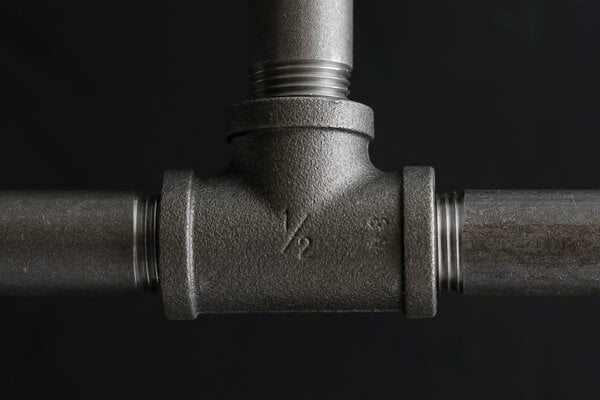Water, natural gas delivery and efficient waste and sewage disposal are indispensable elements of both residential and commercial infrastructure. Behind the scenes, pipes and fittings ensure these essential systems work efficiently. At the core of this infrastructure are malleable iron pipe fittings, known for their durability and versatility. This blog takes you into the world of galvanized malleable iron pipes and fittings, explaining why they matter, how they’re made and the many ways they’re used across various industries.
Ensuring durability in critical infrastructure
Professionals across industries like oil and gas, plumbing and construction trust in the reliability of galvanized malleable iron pipes and fittings for their projects. The skepticism once surrounding galvanized pipes for natural gas transport, arising from the possibility of zinc flaking, has been addressed by advances in zinc coating technologies. These innovations prevent degradation and ensure the zinc coating remains unreactive to natural gas.
The creation of malleable iron threaded fittings is a sophisticated casting process governed by stringent processing and metallurgical standards. These fittings are subsequently galvanized, enveloping the iron in a protective zinc barrier that shields against environmental and internal corrosive elements, significantly extending the lifespan of the piping infrastructure.
It's crucial to differentiate between malleable iron and steel fittings, as the two are not interchangeable. Galvanized malleable iron, characterized by its annealed state that reduces carbon content, offers superior ductility over steel. This ductility not only enhances its resilience but also allows for slight modifications to suit specific installation needs.
Reviewing the versatile applications of galvanized malleable fittings
Galvanized malleable fittings are renowned for their versatility and durability, making them indispensable across a range of applications. Whether in marine environments where corrosion resistance is crucial, or in residential and commercial water piping transport systems ensuring reliable water supply, these fittings shine.
Additionally, their structural strength makes them ideal for use in scaffolds and railings, providing stability and support. Moreover, their ability to convey various media like steam, oil, air and gases further demonstrates their adaptability to diverse needs and environments.
Understanding standard compliance and quality assurance
Understanding the critical importance of compliance with industry standards is important in ensuring the reliability and safety of threaded fittings. Brennan's Class 150 malleable iron threaded fittings stand as the gold standard in the industry, meeting rigorous standards like ASME B16.3, ASTM A197, and other essential benchmarks. This commitment to compliance ensures that Brennan’s fittings consistently deliver unparalleled quality and reliability, meeting the stringent requirements of various applications across industries.
Here are the standards in more detail:
- ASME B16.3: Malleable iron threaded fittings.
- ASTM A197: Malleable iron casting in categories of metal, ferrous metal, cast iron and malleable iron, which are free of primary graphite.
- ASME B16.14: Ferrous pipe plugs, bushings and locknuts used with pipe.
- ASTM A153: Hot-dip zinc coating on iron and steel hardware.
- ASME B16.39: Pressure/temperature ratings, size, marking, materials, strength, testing, sampling, coatings and dimensions for threaded malleable iron unions.
- ASME B1.20.1: Dimensions and gaging of the most common pipe threads, including NPT, NPSC, NPTR, NPSM and NPSL.
Among the listed NP pipe threads, NPTR is designed for non-gas/non-liquid transport applications. This thread is used on scaffolding, stair railings and other mechanical applications, though these are popular applications for galvanized pipe and fittings. NPTR threads will not provide the necessary thread engagement of other NPT styles that are used to perform water, gas or hydraulic functions and the two thread styles should not be confused. In addition to NPT thread forms, malleable fittings are available in other thread styles, such as BSP and G (Whitworth parallel threads).
Exploring different fitting styles
Galvanized malleable iron pipe fittings are among the most frequently used and recognizable styles of any application globally. They encompass an array of styles, including elbows, tees, unions and many more, catering to a broad spectrum of installation requirements.
Fitting styles include the following:
- Unions
- Reducers
- Locknuts
- Caps
- Crosses
- Hex bushings
- Lateral Y branches
- Tees
- Wastenuts
- Floor flanges
- Extensions
- Nipples
- Elbos, with 45- and 90-degree styles as the most popular
Connecting galvanized iron pipe and fittings
Achieving a leak-tight seal is essential when connecting threaded galvanized iron pipes, especially for transporting liquids or gases in non-structural applications. Proper installation not only prevents leaks but also ensures the longevity and efficiency of the piping system. Follow these steps for a secure connection:
- Prepare the Threads: Before assembling the fittings, ensure that the threads on the pipe and the fitting are clean and debris-free. Applying PTFE plumber's tape or pipe dope to the threads helps create a tight seal and reduces the risk of leaks.
- Hand-Tighten the Connection: Start by hand-tightening the connection between the pipe and the fitting. This initial tightening ensures proper alignment and prevents cross-threading, which can lead to leaks and damage to the threads. Hand-tightening also allows for adjustments before applying final torque with pipe wrenches.
- Securely Tighten with Pipe Wrenches: Once the connection is hand-tightened, use pipe wrenches to securely tighten the fitting while holding the pipe steady. Apply gradual pressure and torque to achieve a snug fit without over-tightening, as excessive force can damage the threads or distort the fitting.
- Inspect for Leaks: Inspect the joint thoroughly for any signs of leakage after completing the connection. Use a leak detection solution or soapy water to identify any bubbles forming at the connection points. If leaks are detected, recheck the tightness of the connection and apply additional tape or pipe dope if necessary.
Following these steps, you can ensure a leak-tight seal and reliable performance from your threaded galvanized iron pipe fittings. Regular inspection and maintenance further contribute to the longevity and efficiency of the piping system, minimizing the risk of costly repairs and downtime.
Conclusion
Galvanized malleable iron threaded fittings and pipes are indispensable across a range of applications, from fluid transport to structural frameworks. The protective zinc coating safeguards the system against corrosion, prolongs its service life and prevents blockages from mineral build-up. Available in various thread styles to suit different applications, these fittings combine durability with flexibility, thanks to the annealing process that enhances their malleable properties.
Learn more about Brennan’s fittings by downloading the “Plumbing &HVAC Catalog.”


